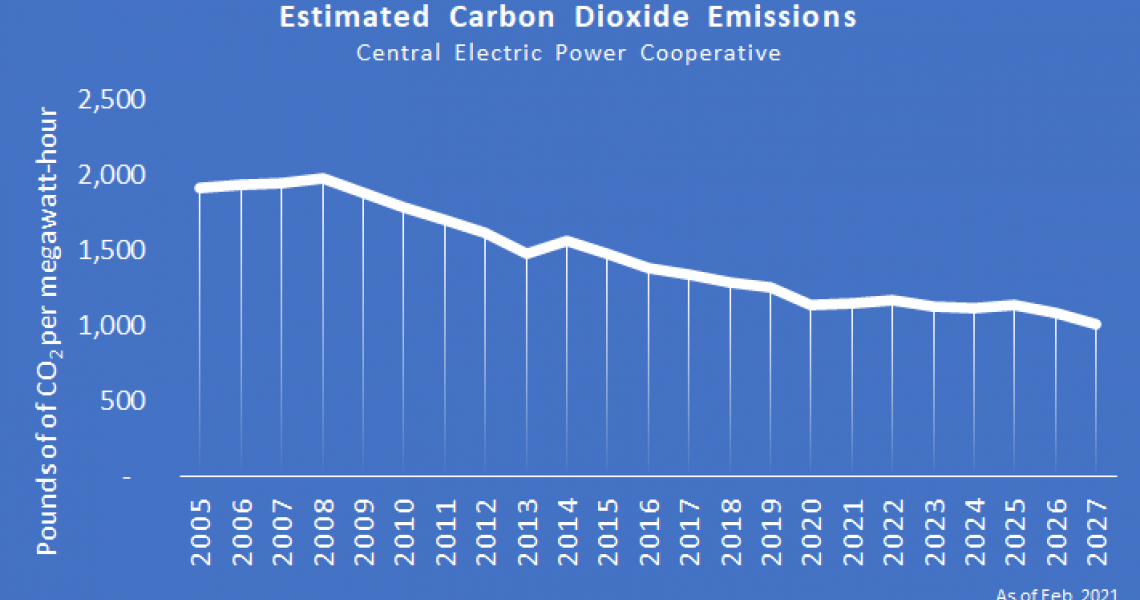Estimated carbon dioxide emissions
COLUMBIA, S.C. — The electricity sold by the state’s electric cooperatives causes lower greenhouse gas emissions than in 2005 and will cause even lower emissions through 2017, according to information released today by the cooperatives’ power supplier.
Central Electric Power Cooperative aggregates the electricity sources for the 20 independent, consumer-owned cooperatives that deliver electricity to 1.5 million South Carolinians.
The amount of carbon dioxide (CO2), a greenhouse gas, emitted to produce that power in 2020 dropped by 41% since 2005, compared to a 17% target used by the United States as a national goal.
Cooperatives are achieving this result by 1) adopting new technologies that do not rely on burning fossil fuels to produce electricity, 2) urging their power suppliers to close older, coal-burning power plants and 3) making agreements with power suppliers whose generating portfolios have lower emissions.
Burning fossil fuels, such as coal and natural gas, to make electricity releases CO2 and other greenhouse gases into the atmosphere and contributes to climate change.
By 2027, electric cooperatives in South Carolina could see at least a 47% reduction in CO2. (See chart.) Central released the projections based on data from its own suppliers.
“This kind of progress should be celebrated, and Central is proud of the accomplishment,” said Rob Hochstetler, Central’s CEO. “But we have urged our power suppliers, especially Santee Cooper, to accelerate the retirement of uneconomic coal-burning power plants.”
Specifically, Central has encouraged Santee Cooper to accelerate the retirement of four coal-burning units at the Winyah Generation Station near Georgetown, which the state-owned utility has announced will be closed—two in 2023 and two in 2027.
Central has power purchase agreements with Santee Cooper, Duke Energy Carolinas and the Southeastern Power Administration. These suppliers produce electricity using coal, natural gas, nuclear, and water at hydroelectric dams, but the use of coal is being reduced.
Central also has a growing list of power purchasing agreements with solar developers, more of which may be announced this month.
“That’s the beauty of our approach to power supply,” said Rob Hochstetler, Central’s CEO. “Rather than owning power plants, we make power purchase agreements. As agreements expire, we’re able to bring in electricity from more environmentally friendly sources such as solar.”
“Clearly, the power purchase approach works on a large scale because electric cooperatives serve a third of the state’s population,” Hochstetler said.
This trend of reduced emissions is reflected nationally in the “Annual Energy Outlook 2021” from the U.S. Energy Information Administration, issued on Feb. 11.
“U.S. energy-related carbon dioxide (CO2) emissions will decline for most years through the mid-2030s,” the report projects.
Though the report includes energy use by other economic sectors such as transportation, it states that the decreases “will largely be a result of changes in the carbon intensity (carbon dioxide per British thermal unit) of the fuel mix, especially in the electric power sector.”
“There’s more to the increased use of carbon-free energy than meets the eye,” said Hochstetler. “A growing amount of renewable energy is being produced by consumers themselves.”
The electricity generated on the user’s side of the electric meter—usually by solar panels in South Carolina—is not measured in Central Electric’s data.
“We estimate as much as 20 megawatts of electricity are produced by some of the 800,000 co-op members across the state,” Hochstetler said. “Since it’s used directly by the co-op members and doesn’t go through the electric meter, it may not be measured, but we know it’s there.”
Cooperatives also have created a large network of community solar installations across the state. Community, or shared, solar is renewable energy, locally produced, for co-op consumer-members who want it, as explained at www.myscsolar.com.
# # #
Central Electric Power Cooperative provides wholesale electricity from multiple sources to South Carolina’s 20 distribution cooperatives. Together, the independent, not-for-profit cooperatives supply power to almost 1.5 million South Carolinians through over 800,000 residential and business memberships. The members, who are the consumers, own the utilities. www.cepci.org

